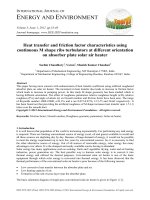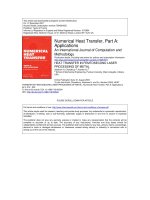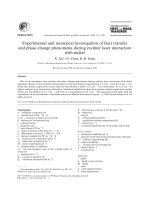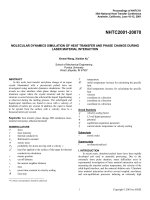Tutorial lecture on nano heat transfer
Bạn đang xem bản rút gọn của tài liệu. Xem và tải ngay bản đầy đủ của tài liệu tại đây (2.71 MB, 74 trang )
A Special Tutorial Lecture Series on
Introduction to Nanoscale Heat Transfer
“If I were asked for an area of science and
engineering that will most likely produce the
breakthroughs of tomorrow, I would point to
nanoscale science and engineering.”
-Neal Lane
Former Assistant to the President for
Science and Technology
An artistic view of a step-shaft
built with atoms
Tai-Ran Hsu, Professor
Department of Mechanical and Aerospace Engineering
San Jose State University
San Jose, California, USA
Part 1: Overview of Nanotechnology
Part 2: Atomic Structure & Quantum Physics
Part 3: Inter-Molecular Heat Transmission
(Nanoscale Heat Transfer
)
Part 4: Measurements of Thermophysical Properties
Part 1
Overview of Nanotechnology
November 14, 2006
•
••
• “Dust” sized super-intelligent computers.
•
••
• “Needle-tip” sized robots for biomedical
applications and for search and rescue.
• Spacecraft weighing less than today’s family
cars.
•
••
• Biomedicine, e.g. in-vivo systems and
surgery that can sustain human lives to 150
years and longer.
•
••
• Robots with artificial human intelligence
becoming the mainstream workforce in our
Society.
•
••
• Unlimited supply of clean renewable
energies that replace all fossil fuel produced
energies on the Earth.
• Tele-transportation systems that can
transport human anywhere on Earth in
seconds.
• Spacecraft for human/cargo inter-planet
traveling.
• New vaccines and medicines that cure many
incurable diseases.
• Synthetic antibody-like nanoscale drugs and
devices seeking out to destroy malignant cells
in human or animal bodies.
• In-vivo medical diagnostic and drug delivery
systems.
• Smart surface coating materials with self-
adjusting thermal conductance for buildings
and refrigeration systems.
•
••
• Smart fabrics for self-cleaning clothe.
• Super-strong materials for light weight
airplanes, vehicles and structures.
• Clean energy conversion systems and super-
long life batteries.
• New breed of crops and domestic animals that
can feed entire world population.
“Dream” ProductsNear-term Products
Futuristic Industrial
Products
in the New Century
HSU-2005
The Core Technology for Producing
Futuristic Industrial Products is
MINIATURIZATION
Two phenomenal examples of
miniaturization of industrial
products in recent years
Miniaturization of Digital Computers
- A remarkable case of miniaturization!
The ENIAC Computer in 1946
A “Lap-top” Computer in 1996
A “Palm-top” Computer in 2001
Size: 10
6
down
Power: 10
6
up
Size: 10
8
down
Power: 10
8
up
This spectacular miniaturization took place in 50 years!!
Market Demand for Smaller, Multi-Functional Products
For example, the market development of cellular phones:
Less than 10 Years Ago:
Current State-of-the Art:
Transceived voice only
Transceives voice+ multi-media + others
(Video-camera, e-mails, calendar, TV and
access to Internet; and a PC with key board)
Size reduction
Palm-top Wireless PC
Latest additional function to cell phones: The Global Positioning Systems (GPS)
Enabling Technologies for Miniaturization
Miniature devices
(1 nm - 1 mm)
** 1 nm = 10
-9
m ≈
≈≈
≈ span of 10 H
2
atoms
Micro Systems Technology
(MST)
(1 µ
µµ
µm - 1 mm)*
Initiated in 1947 with the invention of
transistors, but the term “Micromachining”
was coined in 1982
* 1 µ
µµ
µm = 10
-6
m ≈
≈≈
≈ one-tenth of human hair
Nanotechnology (NT)
(0.1 nm – 0. 1 µ
µµ
µm)**
Inspired by Feynman in 1959, with active
R&D began in around 1995
There is a long way to building nano devices!
A top-down approach
A bottom-up approach
Nanotechnology is the creation of USEFUL/FUNCTIONAL
materials, devices and systems through control of matter on the
nanometer length (nm) scale and exploitation of novel phenomena
and properties (physical, chemical, biological) at that length scale.
What is Nanotechnology?
A Perspective of Nano Scale:
1 nm = 10
-9
m = 10
-6
mm = 10
-3
µm
Length Scale in Nanotechnology
milimicronanopicofemtoatto
Length(m)
0 10
-18
10
-15
10
-12
10
-9
(nm)
10
-6
(µm)
10
-3
Human
Hair:10
-4
m
Virus: 10
-7
m
DNA < 3 nm
Protein: 2-5 nm
Typical atom: 10
-10
m
or one Angstrom
Typical electron
Radius: 2.8x10
-15
m
All matters that exist in universe are made of atoms
and molecules.
The way molecules of various shapes and surface features
organize into patterns on nano scales determines
important material properties (e.g. electrical conductivity,
optical properties, mechanical strength, etc.)
Nano technology will enable us to synthesize nano structures
and control how scale patterning unfolds. From which we can
design and create new sets of matters with desired properties
and characteristics.
Why Nanotechnology?
Active R&D in Nanotechnology:
inspired by Richard Feynman’s speech in 1959
Feynman, R., “There’s Plenty of Room at the Bottom: An invitation to
enter a new field of physics,” (miniaturization) first presented at the American
Physical Society at California Institute of Technology on December 29, 1959.
Subsequent publication in ‘Engineering and Science’, Caltech, February 1960.
(1918 - 1988)
A visionary and a Nobel Laureate in Physics, 1965
The Very First Man-Made Nano Structure -
The “Buckyball”
Made from the Buckminsterfullerene -
a third form of pure carbon molecule.
(after the name of a futurist, R. Buckminster Fuller)
It contained 60 carbon atoms in the shape of a
soccer ball with a diameter of 0.7 nano meter.
Created in 1985 by a chemistry professor,
Richard Smalley from Rice University -
a Nobel Laureate in 1996.
• Electronics, Computing
and Data Storage
• Materials and Manufacturing
• Health and Medicine
• Energy and Environment
• Transportation
• National Security
• Space exploration
•
•
Nanotechnology is an
enabling technology
Major Impacts of Nanotechnology
(source: Meyya Meyyappan, NASA Ames)
• Processors using molecular electronics with declining energy use and cost per
gate, thus increasing efficiency of computer by 10
6
.
• Small mass storage devices: multi-tera (10
12
) bit levels.
• Integrated nanosensors: collecting,
processing and communicating
massive amounts of data with minimal
size, weight, and power consumption.
• Higher transmission frequencies and
more efficient utilization of
optical spectrum to provide at
least 10 times the bandwidth now.
• Display technologies.
• Quantum computing.
Nanotechnology Benefits in Electronics and Computing
(source: Meyya Meyyappan, NASA Ames)
Heat = Horrendous challenge
to mechanical engineers !!
TWO DISRUPTIVE HEAT TRANSFER
TECHNOLOIES
(1) Nanoscale Heat Transfer in
Nano Transistors
(2) Nanoscale Data Storage
Systems
(1) Nanoscale
Heat Transfer
in Nano Transistors
Nanotechnology Benefits in
Electronics and Computing
The Nanochip
Nano transistors
Gates
SiO
2
film
Silicon substrate
(thin pure silicon film)
Advantages: (1) Low unit cost.
(2) Narrow gates for faster on-off
boost speed limit of the integrated circuits.
Nanotechnology Benefits in
Electronics and Computing
Intel roadmap on nano transistors
using micro
technology:
90 nm
65
45
32
22
2003
2005
2007 2009 2011
Year
Transistor Size
I
nc
r
e
a
s
e
L
e
a
k
a
ge
-
A
n
ot
h
e
r
m
a
j
o
r
c
h
a
l
l
e
ng
e
!
Single-
Electron
Transistor
?
Silicon-based
-technology
Possible materials?
Nanotechnology?
(Likely technology)
Length: 50 nm
L = 30
L = 20
L = 15
L = 10
Gate oxide: 1.2 nm
Gate oxide: 0.3 nm
Heat dissipation and leak of electricity are two critical technical problems
in further miniaturization of transistors.
Possible Solutions
Cooling by nanofluidics involving nanoscale
fluid flow in nanoscale channels.
Cooling by Nanoscale heat pipes.
(2) Nanoscale Heat Transfer:
Nano Data Storage System
Nanotechnology Benefits in Data Storage-1
The ever-increasing demand for high density information storage:
Nanotechnology Benefits in Data Storage-2
Data Storage Requirements:
Density Data rate
Error rate Overall reliability
Re-writability Data retention
Tracking Cost
Source: “Scanning Probes Microscope & Their Potential for Data Storage,” John Mamin,
IBM Almaden Research Center, San Jose, CA. (Private communication)
Nanotechnology Benefits in Data Storage-3
The continuous demands for high density data storage has passed the
limit of traditional electromagnetic means.
A new concept of “Read-Write” is being developed – the “Millepede” project
by IBM, San Jose and Zurich, Switzerland.
Working principle involving indenting the surface of polymer film using AFM.
Nanotechnology Benefits in Data Storage-4
Encouraging initial results of the Millipede development:
40 nm bit size
Heat Conduction & Dissipation
in Nanometer Dots









